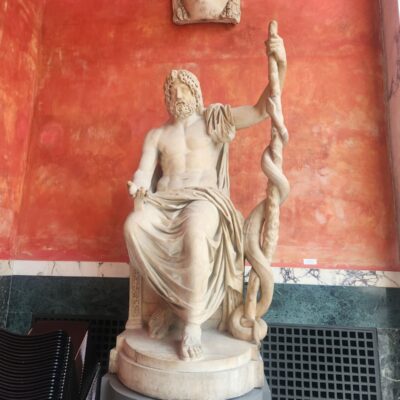Chapters
Aesculapius was the Roman god of the medical arts. His children were: Hygeia, Iaso, Aceso, Aglaea, Panacea, Machaon, Podalirius, Telesphoros, Aratus. Its Greek counterpart was Asclepius, from whom most of the information was taken for Roman mythology. Aesculapius was often associated with Veiovis, a very old Roman deity. Aesculapius was one of the many sons of Koronis and Apollo with whom he shared the epithet Paean (“Healer”). To this day the rod of Aesculapius is a symbol of medicine.
His mother, Koronis, was killed for being unfaithful to Apollo and laid on the funeral pyre. However, her unborn child was saved from her womb. Another story tells that Koronis died in childbirth, and Apollo saved his son by removing him from the womb of his mother’s body at the stake. From this event, Aesculapius received his name. Apollo then carried the child to the centaur Chiron, who looked after the young god and taught him the art of medicine.
Aesculapius’ wife was Epione, with whom he had 6 daughters and 3 sons. His son Aratus was from a relationship with Aristodama. Aesculapius was struck by lightning by Jupiter for resurrecting the hero Hippolytos.
The attributes of Aesculapius were snakes wrapped around a stick, spruce cones, laurel wreaths, sometimes a goat or a dog.
Aesculapius was admitted to the pantheon of Roman deities in 291 BCE when during the plague, he was built a temple on an islet in the Tiber. However, it was not until the 2nd century CE. He became an important god for the Romans, who was not only a healer of the body but also the saviour of souls. A morally correct attitude guaranteed his followers initiation into the posthumous life.
Relationship with Jesus
Christians were hostile to this returning (in the 2nd century CE) to the favours of worship, as there were many similarities between Christ and Aesculapius. They were both born of God and of a woman, they were merciful, they had the power to heal and help those in need – with Aesculapius giving such help only to the righteous. The expressions of dislike on the part of the followers of Jesus of Nazareth can be found in the texts Tertullian, Lactantius or Eusebius. They considered Aesculapius to be a false copy of their Messiah. The attitude of Christians has eased thanks to Clement of Alexandria (2nd-3rd century CE), who appreciated the positive features of the cult.
But where does Aesculapius’ popularity come from? In the Greco-Roman world, people valued health as a source of happiness. This deity was close to all social strata: both patricians and plebeians. Temples – Asclepions – were built throughout the Empire, which was largely financed by private donations from richer classes. This proves how many believers amassed the cult of Aesculapius.
Asclepeions
Asclepeion, the temple of Aesculapius, also served as a hospital and sanatorium. The sick were subjected to cleansing treatments, such as fasting and bathing, and magical treatments (which Hippocrates fought). The main healing method was through hypnotic sleep in the temple grounds. Aristophanes writes about this healing in the comedy Plutos. The healed left exvota represents the healed parts of the body (eg arms, legs); recorded history of disease and healing in the form of inscriptions left in the temple; they threw coins into the sacred pool.
Later, Emperor Claudius issued an ordinance granting freedom to every slave who was healed there.








